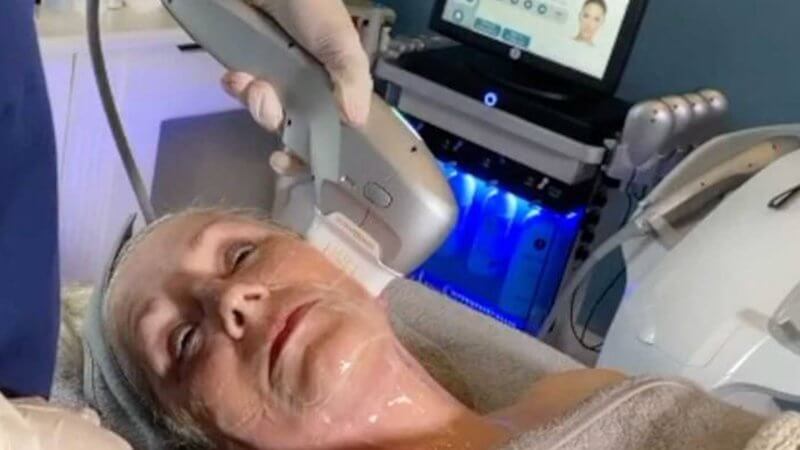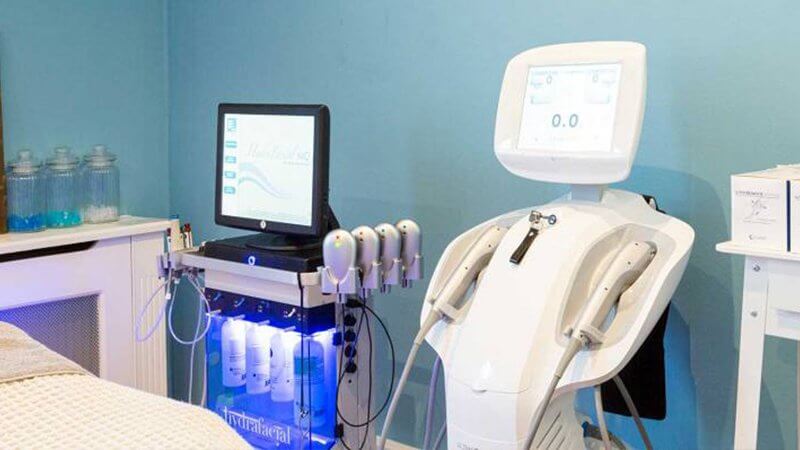Now more than ever, we’re searching for ways to get a ‘natural’ look, and take control of our appearance. While skin ageing is an entirely natural process, so too is taking steps to look – and feel our very best, wherever we are in life.
Over the past decade, the HIFU facelift has become extremely popular for its ability to achieve natural-looking anti-ageing results in the face, jawline and neck. It is hailed as offering a non-invasive, non-surgical facelift to those who seek to revitalise loose or sagging skin without the need to take drastic measures.
HIFU (High Intensity Focused Ultrasound) is unique in its ability to ‘penetrate’ the superficial layers of the skin without the use of needles or surgery. It creates impressive results by merely stimulating the body to work on rebuilding its own structural support.
But, even though it rivals the long-established surgical facelift as a lower-risk and cost alternative, many people remain unsure quite what a HIFU treatment entails. If you are wondering whether a HIFU facelift is right for you, then find out everything you need to know — from the science to the side effects — in our ultimate guide below.
Like what you see? Book an appointment with one of our fully trained technicians for a HIFU Facelift.
What is a HIFU Facelift?
High Intensity Focused Ultrasound or HIFU treatments offer a non-invasive alternative to the surgical facelift.
As we grow older, we begin to lose collagen and elastin in our skin. These naturally-occurring proteins are mainly responsible for the youthful definition, structural support, and elasticity we all take for granted in our younger years.
The natural ageing process starts in our twenties, as the skin becomes less saturated with these proteins. Eventually, we will begin to notice a loss of volume, particularly around the eyes and cheeks, and ‘loose’ or sagging skin. For many people, the jawline will start to appear less defined, which can cause jowls to appear, or lead to new pockets of fat forming under the chin.
The HIFU facelift is a relatively new cosmetic treatment option for those who wish to reintroduce elasticity and tightness to the face, without the need for surgery.
It utilises focused ultrasound energy to stimulate deep into the layers of skin integral to the structural support of our faces, using heat. This procedure causes a minimal amount of damage to the cells, which react by producing new collagen and elastin within the structural support layers of the skin. By triggering the body to focus on renewing this foundational layer, the results are impressive, achieving facial rejuvenation without ever appearing unnatural or overly drastic.
Following a HIFU facelift, patients should expect to see immediate improvement, which will progress over the following three months as the body continues to replenish its stores of collagen and elastin.
Who is a suitable candidate?
The HIFU facelift, also known as Non-Surgical Facelift, is an ideal treatment for anyone experiencing mild to moderate skin laxity. A term used to describe the loose skin we all begin to see around the brow line, eyelids, cheeks and jawline.
As such, it has proven an incredibly popular procedure among patients aged 30+ who wish to achieve firmer skin, elasticity and contouring in the face and neck as the natural ageing process takes place. This nonsurgical skin tightening procedure is ideal for fine lines and skin lifting and encourages overall facial rejuvenation.
As with any cosmetic procedure, the results will always vary depending on the individual’s facial structure, age, and lifestyle, which is why consulting with your practitioner before the appointment is so necessary. They have a deep understanding of facial anatomy and will be able to come up with a plan for treatment that is perfectly tailored to your face.
The differences between HIFU and a Surgical Facelift
While HIFU treatments have gained considerable traction with men and women over the last few years. Surgical facelifts, also known as a rhytidectomy procedure, have been a popular option for decades.
We’ll compare both options to help you decide which procedure aligns best with your skin tightening aims and expectations.
Surgical Facelift Procedure
A typical surgical facelift will be completed by making an incision into the temples, behind the ear, and in the lower scalp. Anything above the eyes is known as a brow lift.
With these incisions are made, surgeons can then remove excess skin and effectively ‘drawback’ the remaining skin to create a firmer, tighter look in the face and jawline. The procedure typically takes several hours to complete.
As this is an invasive treatment, the patient will be placed under general anaesthesia, and will usually be required to spend a night in the hospital to ensure there are no complications.
During their initial recovery for a surgical facelift, patients will be prescribed pain medication to mitigate any discomfort. They will need to attend a follow-up appointment with their surgeon to have the incision checked, and dressings reapplied.

HIFU Non Surgical Facelift Procedure
A High Intensity Focused Ultrasound (HIFU) facelift typically takes under an hour to complete, and no anaesthesia is required. Those who have undergone a HIFU skin tightening treatment sometimes notice a light, warm prickling sensation in the skin.
Following the completion of the procedure, patients are free to resume normal activities and should only expect to see minor side effects. Rarely bruising and swelling is seen and will typically subside around two weeks into your recovery. The full effects of the facelift typically take up to 3 months to become fully visible.
Unlike surgical facelifts, HIFU side effects are limited to mild swelling in the areas treated — and many patients experience no negative after-effects at all. As such, the treatment requires no downtime, which means you can even have it done on your lunch break. You will begin to see results as soon as you leave the clinic, and this improvement will continue over the following months.
The long term results
The longevity of surgical facelifts varies quite drastically depending on the type of procedure patients choose. A full facelift offers the most drastic results, as it targets a wider area; generally, the results are reported to last up to fifteen years following the operation.
A mini facelift will target specific areas, such as sagging in the lower cheeks, jawline and neck. They don’t last quite as long as a full facelift – about seven years.
HIFU nonsurgical skin tightening procedures do not offer such long term results. A single session should be expected to last for between twelve and eighteen months. However, they do provide a lower-risk and cost alternative to surgery, with a major price difference having far less of an impact on your purse. In addition to this, the noninvasive skin tightening procedure provides much more natural results than a traditional surgical facelift.
Risks to consider
Surgical Facelifts
As is always the case with surgical procedures, there are several risks to be aware of if you are considering a more invasive treatment.
Considerable progress has been made since the advent of the surgical facelift. But, every surgeon and patient are different, so it’s impossible to guarantee that complications will not occur and that you will be happy with the results.
Bleeding, infection and nerve damage, while relatively rare, are some of the risks to consider.
For some patients, a surgical facelift can result in an asymmetrical appearance or visible surgical scars at the edges of the face. If this is the case, the patient may need a second procedure to correct the problem, which will require more anaesthesia and lengthen recovery time.
Non Surgical Facelifts
The HIFU facelift, on the other hand, aims to ‘reverse’ signs of ageing encouraging the body to restore its own natural structural support. Which circumvents the risks of patients experiencing a drastic change to their appearance. What’s more, the procedure itself is very safe and doesn’t carry the same risks of anaesthesia, bleeding and infection as surgery. Patients may experience a slight tingling sensation during the procedure, with mild redness directly after, but the mild side-effects subsides over a short period of time.
Does HIFU damage the skin over time?
The HIFU machine works by creating microdamage in the foundational layers of skin, which triggers a natural, ‘healing’ response within the body. This damage, however, is not detectable on the surface of the skin, as the ultrasound energy only affects the tissue deep below the superficial layers.
Patients can return for top-up treatments without experiencing any damage or deterioration in the skin. Since the procedure does not require the use of needles or incisions, even minor short-term damage and the risk of infection and scarring is avoided.
How much does a HIFU treatment cost?
Not only does HIFU offer a non-invasive alternative to other popular skin tightening treatments, but it’s also much cheaper.
As you consider this treatment, bear in mind that it is not as long-lasting as a full surgical facelift – the cost for which can be in the region of £10,000. So many patients do choose to return a year or so later for a top-up treatment.
Here are our current HIFU prices – you can see our full range of treatment prices here.
- Full Face and Neck with 12 week repeat top up treatment £1,200
- Go Cardless – an initial deposit of £500 and then 4 monthly payments of £175
- Neck, Jaw and Chin with a 12 week repeat top up treatment £650
- Eyes or per-oral area including a 12 week repeat top up treatment £550
What to look for in a good practitioner
Choosing to undergo any anti-ageing treatment is an extremely personal experience. It’s important that you feel totally comfortable with your aesthetician long before you actually go through with the procedure.
You need to know they will listen to and understand your expectations and concerns. You also need to be sure that they have the skills, qualifications and certifications necessary to achieve the results they promise.
If you need more help, you can read our six-point guide on how to choose the right aesthetic clinic.

Ask yourself the following questions before, during and after your initial consultation.
Are you happy with their before/after photos?
Nothing offers better insight into a clinic’s calibre than their portfolio of past clients. Look for consistency in the lighting, angle and facial expression. A worthwhile practitioner will have reliable results that speak for themselves, and won’t need to rely on photographic trickery to impress future clients.
Do they offer the latest technology?
Anti-ageing treatments are part of a rapidly evolving industry, which means that new techniques and technologies are forever bursting onto the scene, and offering evermore effective results.
Finding an aesthetician ready to invest time and money into keeping up to date with the latest in HIFU facial lifting technology and who offers invaluable insight into their commitment to achieving the best results with their patients.
The equipment we use is the Ultraformer III, an FDA (Food & Drug Administration) medical-grade device. In our opinion, this is the best in the industry offering the most painless and effective results.

How good is their follow-up care?
For your own peace of mind, even the most minor procedure should include an exceedingly high-level of aftercare with the same practitioner who administered the treatment.
It will allow you to feel more confident before the procedure, and ensure that you’ve got the best possible results from your treatment – and your money. A practitioner who works from a permanent clinic is much more likely to be able to provide consistent aftercare to their patients.
Did you feel heard at your consultation?
Even if you’ve been through the process before, it is easy to feel apprehensive before a treatment. We all want to look and feel our best, and entrusting something so important to someone else is, understandably, a nerve-wracking experience.
Use your consultation to build a rapport with the practitioner. Make sure your expectations are understood, and your concerns have been addressed.
If you are made to feel rushed, talked-over, or pushed into something that you are not sure about, then be prepared to walk away and find someone you can trust.
Are they experienced?
As with any skillset or vocation, performing anti-ageing treatments to the highest possible standard requires a great deal of expertise and hands-on experience. The right practitioner will have years’ of practical knowledge, training and successful procedures behind them.
Get in touch
If your mind is made up and you’d like to book a consultation, you can call us on 0203 900 2756 to arrange. We can also discuss other options, and if a HIFU facelift is the best treatment for you.
We are motivated by achieving excellent results from our treatments and tailoring your experience to suit you, and your unique facial anatomy.

